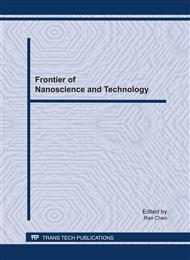[1]
W.D. Johnston and R. R. Heikes: J. Amer. Chem. Soc. Vol. 78 (1956), p.3255.
Google Scholar
[2]
V. R. Hoppe, G. Brachtel and M. Jansen: Z. Anorg. Allg. Chem. Vol. 417 (1975), p.1.
Google Scholar
[3]
L. Croguennec, P. Deniard, R. Brec et al.: J. Mater. Chem. Vol. 5(11) (1995), p. (1919).
Google Scholar
[4]
A. R. Armstrong and P. G. Bruce: Nature Vol. 381(1996), p.499.
Google Scholar
[5]
S-T. Myung, S. Komaba and N. Kumagai: Electrochimica Acta Vol. 47 (2002), p.3287.
Google Scholar
[6]
Q. Liu, D.L. Mao, C. K. Chang et al.: J. Power Sources Vol. 173 (2007), p.538.
Google Scholar
[7]
F. Zhou, X. M. Zhao, Y. Q. Liu et al.: J. Phys. Chem. Solids Vol. 69 (2008), p. (2061).
Google Scholar
[8]
E. M. Jin, B. Jin, Y. S. Jeon et al.: J. Power Sources Vol. 189 (2009), p.620.
Google Scholar
[9]
S. T. Myung, S. Komaba and N. Kumagai: Solid State Ionics Vol. 150 (2002), p.199.
Google Scholar
[10]
J. M. Kim and H. T. Chung: J. Power Sources Vol. 115 (2003), p.125.
Google Scholar
[11]
Y.S. Lee, Y.K. Sun, K. Adachi et al.: Electrochimica Acta Vol. 48 (2003), p.1031.
Google Scholar
[12]
Y. I. Jang, F. C. Chou, B. Y. Huang et al.: J. Phys. Chem. Solids Vol. 64 (2003), p.2525.
Google Scholar
[13]
L. Croguennec, P. Deniard, R. Brec et al.: Solid State Ionics Vol. 89 (1996), p.127.
Google Scholar
[14]
M. Q. Wu, A. Chen, R.Q. Xu et al.: Microelectronic Engineering Vol. 66 (2003), p.180.
Google Scholar
[15]
X-D. Li, W-S. Yang, S-C. Zhang et al.: Solid State Ionics Vol. 176 (2005), p.803.
Google Scholar
[16]
L. Croguennec, P. Deniard, R. Brec et al.: J. Mater. Chem. Vol. 7(3) (1997), p.511.
Google Scholar
[17]
B.R. Strohmeier and D.M. Hercules: J. Phys. Chem. Vol. 88 (1984), p.4922.
Google Scholar
[18]
R. N. Bhowmik and R. Ranganathan: J. Appl. Phys. Vol. 93(5) (2003), p.2780.
Google Scholar
[19]
R. S. Freitas, L. Ghivelder, F. Damay et al.: Pyhs. Rev. B Vol. 64 (2001), p.144404.
Google Scholar
[20]
L. Z. Zhao, G. Chen, F. Y. Li et al.: Acta Physica Sinica Vol. 56(10) (2007), p.6045.
Google Scholar
[21]
J. E. Greedan, N. P. Raju, A. Maignan et al.: Pyhs. Rev. B Vol. 54 (1996), p.7189.
Google Scholar
[22]
C. A. Cardoso, F. M. Araujo-Moreira,. P. S. Awana et al.: Pyhs. Rev. B Vol. 67 (2003), p.020407(R).
Google Scholar
[23]
G. X. Cheng: Raman Brillouin Scattering(Pekin science press, 2003, p.226), in Chinese.
Google Scholar
[24]
L.Z. Zhao, Y.W. Chen and G.R. Wang: Solid State Ionics Vol. 181 (2010), p.1399.
Google Scholar


